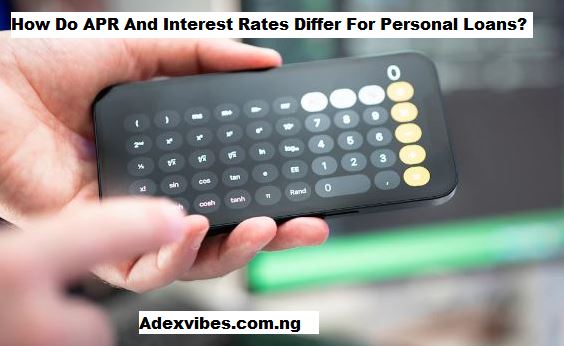When considering a personal loan, one of the first things that can confuse borrowers is the difference between APR and the interest rate. These two terms are often used interchangeably, but they are not the same thing. Understanding how APR and interest rates differ for personal loans is key to choosing the best loan for your needs and avoiding hidden costs. Although the interest rate is typically the most discussed factor in personal loans, APR provides a more complete picture of the cost of borrowing.
The interest rate of a loan is simply the percentage of the loan amount you will pay as a cost for borrowing the money. APR, or Annual Percentage Rate, includes the interest rate but also factors in other charges or fees associated with the loan. This could include things like origination fees or closing costs. Knowing the difference between APR and interest rate will help you assess the true cost of borrowing and avoid surprises down the road.
In this post, we will explore the distinctions between APR and interest rates, their implications on your loan payments, and how they impact the total cost of borrowing. By the end of this article, you’ll have a clearer understanding of how do APR and interest rates differ for personal loans and how these differences can influence your financial decision-making.
Also, READ
How Do Loan Fees Affect My Monthly Payments?
How Can I Find The Lowest Interest Rates For Personal Loans?
Is The Interest Rate The Same As The APR On A Personal Loan?
The simple answer is no, the interest rate is not the same as the APR on a personal loan. While both terms refer to the cost of borrowing money, they represent different things. Understanding what each term means can give you better insight into how they impact your loan.
Interest Rate
The interest rate is the percentage of the loan amount that the lender charges as the cost of borrowing. It is the base cost of the loan. For example, if you borrow $10,000 at a 6% interest rate, you will pay 6% of $10,000 in interest each year until the loan is paid off. The interest rate is calculated annually, but if you have a monthly payment plan, it will be broken down into smaller payments.
APR (Annual Percentage Rate)
APR, on the other hand, is a broader measure of the total cost of borrowing. It includes not only the interest rate but also any fees or additional costs associated with the loan. For example, if there’s an origination fee of $500 for a loan, this will be included in the APR calculation. As a result, the APR will typically be higher than the interest rate because it reflects the full cost of taking out the loan, including both the interest rate and fees.
While the interest rate is important for understanding the basic cost of the loan, the APR provides a more accurate picture of the overall cost. Lenders are required by law to disclose the APR, so you can compare different loans more effectively and avoid loans that seem cheap but come with hidden fees.
What Is 6% Interest On A $30,000 Loan?
Let’s break down what a 6% interest rate on a $30,000 loan means in real terms. Many personal loans offer fixed interest rates, meaning the rate stays the same throughout the life of the loan. But how much will you actually pay with a 6% interest rate?
Calculating The Interest
To calculate the interest on a $30,000 loan with a 6% interest rate, you would multiply the loan amount by the interest rate. For example:
- $30,000 x 0.06 (6%) = $1,800 annually in interest.
This means that each year, you will pay $1,800 in interest in addition to the principal balance (the amount borrowed). However, interest is not always paid upfront. On loans with monthly payments, this interest is typically divided into monthly payments, so your monthly interest cost would be approximately $150.
Monthly Payments and Loan Term
The loan term (how long you have to repay the loan) will affect your monthly payments. If you have a 5-year loan term, you would divide the $30,000 loan by the number of months in the loan term (60 months for a 5-year loan). This gives you the base monthly payment for the loan’s principal. However, you also have to account for the interest added to that amount.
For example, on a $30,000 loan with a 6% interest rate over 5 years, your monthly payment would be around $580. This is a rough estimate and does not include any fees or other factors that could affect your payment.
What Does This Mean For Your Monthly Budget?
When planning your monthly budget, it’s essential to consider both the principal and the interest payments. The 6% interest rate will cause your payments to be higher than the original loan amount, and this is where APR comes into play. If there are additional fees, they would be factored into your monthly payment as well, making your loan more expensive than it initially appears.
Should I Go By APR Or Interest Rate?
When evaluating personal loan offers, you’ll encounter both the interest rate and the APR, and it’s important to understand which one to focus on. The interest rate tells you the cost of borrowing money, but it doesn’t account for additional fees, such as application fees or origination charges, that lenders may impose. The APR, on the other hand, reflects the total cost of borrowing, including both interest and fees.
APR Gives You A Full Picture
Since APR includes fees, it’s the better indicator of the total cost of the loan. If you’re comparing different loan offers, the APR will allow you to evaluate loans with different interest rates and fees on a level playing field. If one loan has a lower interest rate but higher fees, its APR might be higher than another loan with a higher interest rate but fewer fees.
APR is particularly helpful if you want to compare loans with similar terms but different fees. It shows you how much the loan will actually cost you on an annual basis, so you can make a more informed decision.
Interest Rate Alone Isn’t Enough
While the interest rate gives you an idea of how much interest you’ll pay on the loan, it doesn’t reflect any additional costs. If you’re deciding between two loans and one has a much lower interest rate, but a higher APR, the second loan may ultimately be cheaper. Always make sure you factor in both the interest rate and the APR when choosing a personal loan.
What Is The Best Interest Rate For A Personal Loan?
The best interest rate for a personal loan depends on several factors, including your credit score, the loan amount, the loan term, and the lender’s policies. Typically, individuals with good to excellent credit scores will qualify for the lowest interest rates. However, the best interest rate for you also depends on your financial situation and your ability to make timely payments.
Credit Score and Loan Terms
For people with good credit scores (typically 700 or above), interest rates on personal loans tend to range from 6% to 10%. If your credit score is lower, say in the 600s, you may qualify for rates in the 10% to 15% range. The better your credit score, the lower your interest rate, and the less you will pay over the life of the loan.
The loan term also affects the interest rate. Shorter-term loans tend to come with lower interest rates, while longer-term loans may have higher rates due to the longer repayment period and the increased risk to the lender.
Comparing Lenders
To find the best interest rate, it’s important to shop around and compare offers from multiple lenders. Different lenders have different criteria for setting their rates, and some may offer promotional rates or discounts for certain borrowers. Be sure to ask about any fees, as these can significantly increase the overall cost of the loan.
What Is An Acceptable Interest Rate For A Personal Loan?

An acceptable interest rate for a personal loan is one that fits your budget and reflects the terms of the loan. As mentioned earlier, rates can vary based on credit score, loan amount, and term. Generally, an interest rate of 6% to 10% is considered good for borrowers with excellent credit. However, for those with lower credit scores, rates could range from 10% to 20% or higher.
The key is to find a rate that aligns with your ability to repay the loan without putting too much strain on your finances. Look at your monthly budget and make sure the loan payment is manageable. Be aware that the lower the interest rate, the more affordable the loan will be in the long run.
How Much Is A $10,000 Loan For 5 Years?
Let’s say you take out a $10,000 loan for 5 years with a 6% interest rate. Your monthly payment would be approximately $193. This amount includes both the principal repayment and the interest.
If there are additional fees added to the loan, such as an origination fee, this would increase your monthly payment. The exact monthly payment will depend on the specific terms of the loan, including the interest rate and any additional charges.
Conclusion
When comparing personal loans, it’s crucial to understand how do APR and interest rates differ for personal loans and how these differences affect the total cost of borrowing. While the interest rate tells you how much you’ll pay in interest, the APR gives you a more complete picture of the overall cost, including any fees. By considering both the interest rate and the APR, you can make more informed decisions about which loan is best for your needs.
Whether you’re looking for a low-interest loan or a loan with fewer fees, understanding the full cost of borrowing will help you avoid financial surprises. Always shop around, compare offers, and choose the loan that makes the most sense for your budget and financial goals.






